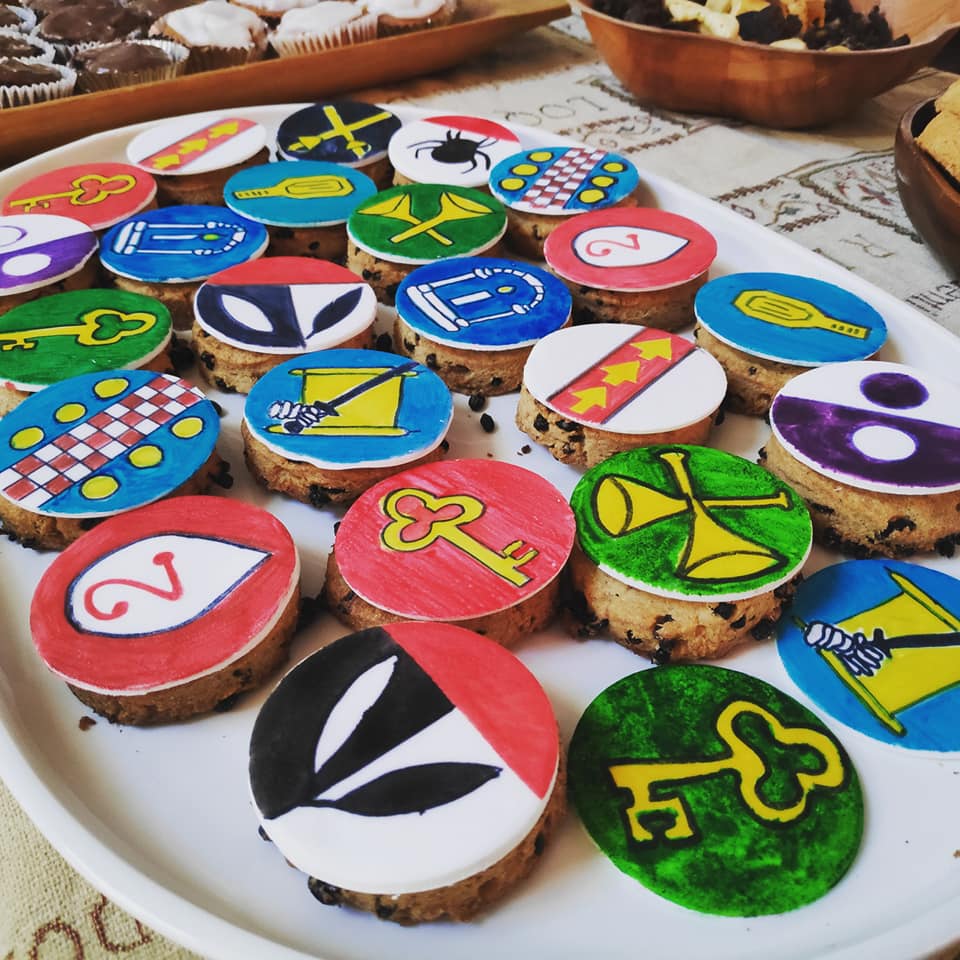Newcomer’s Page
What is the SCA? | Events | Martial Activities | Arts and Sciences | Knowne World | Getting Started | What to Wear | What to Bring | What to Do | Who to Be | Who’s Who in the SCA | Children in the SCA |Local SCA Administrative Officers |

Welcome to the Society for Creative Anachronism, also known as the Society or SCA. Prepare yourself to step into a world of chivalry, art and camaraderie – a world shared by over 50,000 others who seek the same dream as you do. Armoured knights are locked in combat on the list field, artisans under brightly-coloured pavilions are painting illuminated manuscripts, and friends nearby put the finishing touches on their newest gowns, all with Renaissance music playing softly in the background.
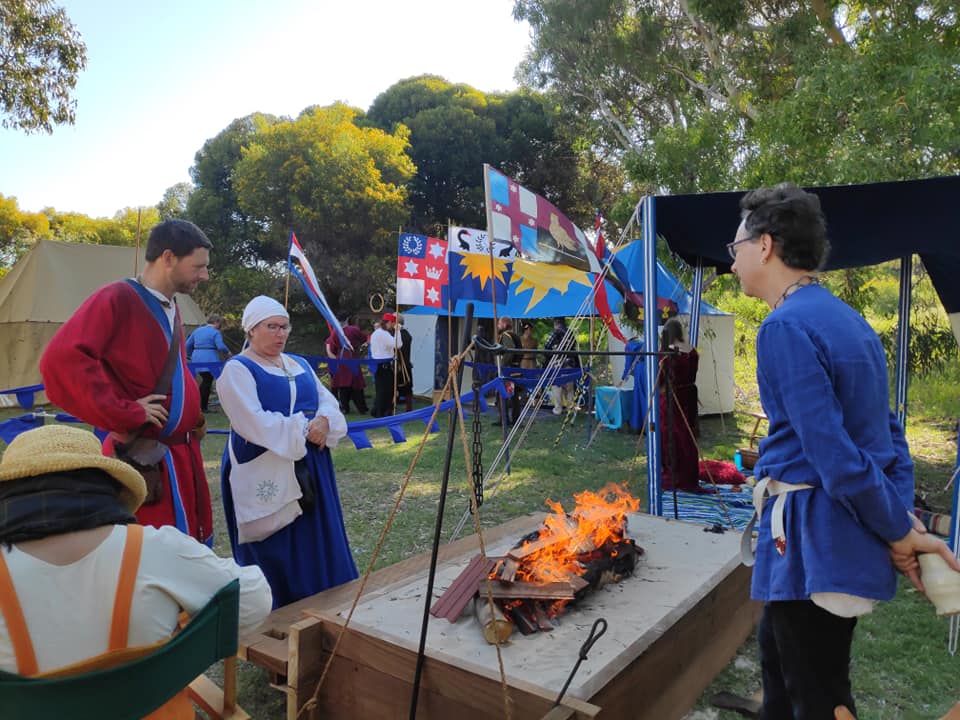
What is the SCA?
[Top]
The SCA is incorporated in the US as a 501(c)3, not-for-profit educational organisation. It is part of the “living history” movement, which means that SCA members have a “hands-on” approach to history, engaging in activities that help them to explore the culture, arts and sciences of ages past. The SCA period encompasses pre-17th century Western Europe, with an emphasis on the Middle Ages and Renaissance.
We encourage research and study of the time period and provide venues and publications in which our knowledge can be shared with others. Almost every local SCA group holds informal practices, classes and craft meetings for honing new skills. The things we learn and research are put into practice when we hold our regular activities, re-creating what we can about an era.

Events
[Top]
The Society’s major venue for re-creation is the event, which is a general term for a gathering at which everyone dresses in clothing based on styles worn in the Middle Ages and Renaissance. Participants come together at a site (a rented hall or camping ground) to share what they have learned and to have a good time with friends. SCA events have many different formats:
- A martial arts tournament (sword-fighting, or rapier)
- A display of artistic skill
- Archery
- A medieval feast
- A Royal Court
- Or a combination of all of these.
Most events encompass several areas of interest to involve more of the general populace. Events can run from just one afternoon to a long war at which members set up camp for a week or more. Most events are one day or one weekend in duration.
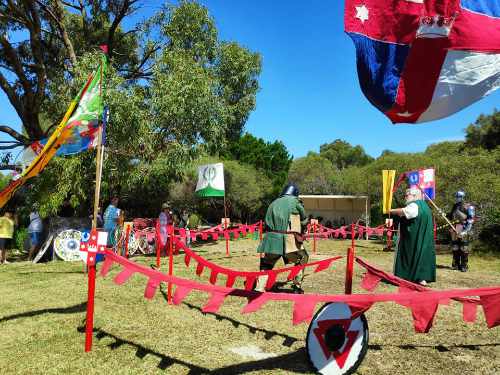
Martial Activities
[Top]
The most visible focus of many SCA events is our martial activities. Many SCA members re-create the armoured chivalric combat of the High Middle Ages, wearing replica armour and using rattan weapons that have the balance and handling properties, but not the lethal effect, of the originals. Armoured combat evolved from what happened when two armed knights were unhorsed and had to fight on the ground.
In most regions, there are also those who strive to re-create Renaissance fencing using various styles of rapiers, like epees or schlagers.
Some meet to test their skills with the bow, either by shooting directly against armoured combatants with padded arrows or by shooting at targets on an archery field. Others practice against targets with thrown weapons, including knives, axes and spears. In addition, the thunder of hooves may announce the successful completion of an equestrian obstacle course or tilting at rings. Simulated rocks and missile weapons may fly through the air in tests of siege weaponry.
Combatants of all types follow a system of rules and extensive training that permits a realistic and energetic sport while maintaining a sterling safety record. Fighters are on their honour to call blows, meaning they must admit whether a blow received would have wounded or incapacitated them had it been a ‘real’ weapon.
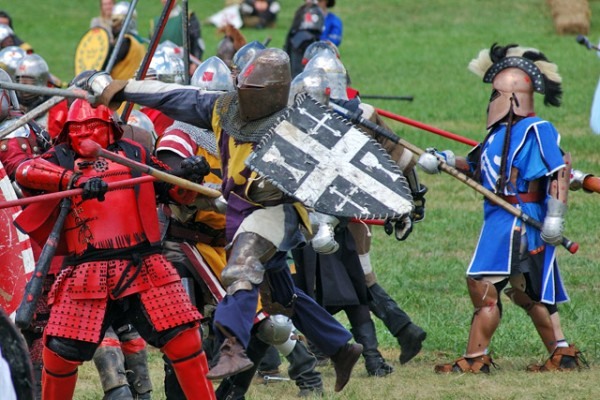
Arts and Sciences
[Top]
Less immediately obvious to new members are all the other period activities people do in the SCA. The range of arts and sciences, everyday skills, and technical knowledge is enormous. Period activities range from bardic performances:
- Reciting poems
- Singing songs
- Playing medieval music on medieval instruments
- Telling of stories
To the arts and sciences:
- Cooking
- Glass work
- Armour making
- Dancing
- Needle work
- Herbalism
- Calligraphy
- Brewing
- Vintning
- Weaving
Among many other pursuits. In addition, there are a variety of technical and social skills that help establish the ambiance of life in a pre-17th century Royal Court, including dance and heraldry. You may be overwhelmed and bewildered by the variety of things people work on, and especially by the skill of many of the people you meet. Observe others and ask questions. If there are guilds or special interest groups that meet in your area, attend some to get to know the people and see what they do. Perhaps you have a skill in the modern world or an interest that can be translated into the SCA world. If you do not know where to start, talk with your local Arts and Sciences Officer to inquire about persons in your area or region who share your interests in a particular skill or craft.

Known World
[Top]
In terms of its own history, the SCA was incorporated in 1968, but the Society counts its years from its first tournament, which was held on 1 May 1966. The SCA divides its Known World into geographic regions called Kingdoms. The Known World currently includes the United States, Canada, Europe, Australia and parts of Asia and Africa. There are 19 Kingdoms, each with its own King and Queen chosen on the field of armoured combat. Within each of the Kingdoms are local chapters known as cantons, shires, baronies, provinces, or principalities, depending on their size and location.
Getting Started
[Top]
You can find your local group by inputting your postcode or suburb. The results give you a link to the website and an email address to contact the Seneschal (President of the local group). Before you attend an SCA meeting (such as a training day or sewing session) it is wise to contact the Seneschal to verify the time and place. You can also determine whether participants wear period/medieval clothes to the meeting, and who to contact to borrow some if you don’t have any yet.
When you arrive to your first meeting, don’t hesitate to mingle or to approach someone and introduce yourself. Explain that you are new and ask who you can talk to about learning more about the group. If someone is working on a project, ask about it. In addition to the general or business meetings, there are also local guild meetings where people who practice a particular art gather to share information and help each other. Additionally, there are fighter practices where there is commonly extra gear that you can use to try out SCA combat for yourself.
Some groups have a person dedicated to introducing and looking after newcomers (known as a Chatelaine or Hospitaller). Some groups also have special meetings for newcomers to help them learn what they need to know to feel a part of the group. Above all, get involved! Volunteer to help out with one of the group’s activities. Although they won’t let you run an event yourself at first, people will be happy to have you help out with the myriad of tasks involved in holding a successful event.
Once you have attended a local meeting, you may want to try attending an event. Local events are listed on the Events page of this website. To find regional Society events, visit the calendar on the Kingdom’s website.
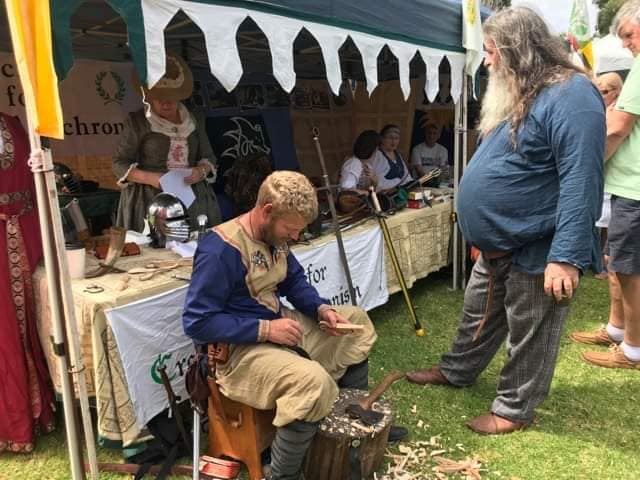
What to Wear
[Top]
The Society is a living history organisation, intended for participants rather than spectators. Everyone who attends an event is expected to wear at least an attempt at pre-17th century clothing (or garb). Clothing need not be fancy. Some groups have loaner garb that first-time attendees can wear. Email your local Chatelaine to see if loaner garb will be available. Society members usually make their own clothes, although sometimes you can commission someone to make you simple clothes. Bartering is another acceptable form of trade, swapping one of your strong skillsets for someone else’s.
Plain-coloured clothing is preferred, and trousers or pants can make good first-time pants. Leather boots and uggies can make excellent shoes, and a blouse or untucked peasant-type shirt will serve as beginner clothing. A plain-coloured long skirt can finish off a feminine ensemble. A cloak, even one made out of a woolen blanket, can hide modern clothes. For accessories, wear a pouch or drawstring purse on your belt.
Do not wear a white belt, sash, or baldric (belt across the chest). White is reserved for members of the Chivalry. Bright colored belts, such as red, green, or yellow, are often used to indicate that the wearer is a student of a particular person who has been honored for excellence in a SCA field of endeavour. Although the colors are not restricted, in some kingdoms there may be a misunderstanding. Necklaces of chain links without medallions or pendants are also worn by special groups. You should avoid them until you ask about local customs.
Avoid wearing a sword until you have asked about what is permissible in your Kingdom. Many people wear knives. There is a special etiquette about bearing a steel blade. To keep the knife or blade from becoming unsheathed accidentally, many people fasten a cord around it to hold it in place. Do not threaten another person with your knife, even in play. Also, don’t handle other people’s property without their permission. Ask before you touch.
A number of resources are available for more accurate reproductions of medieval clothing.
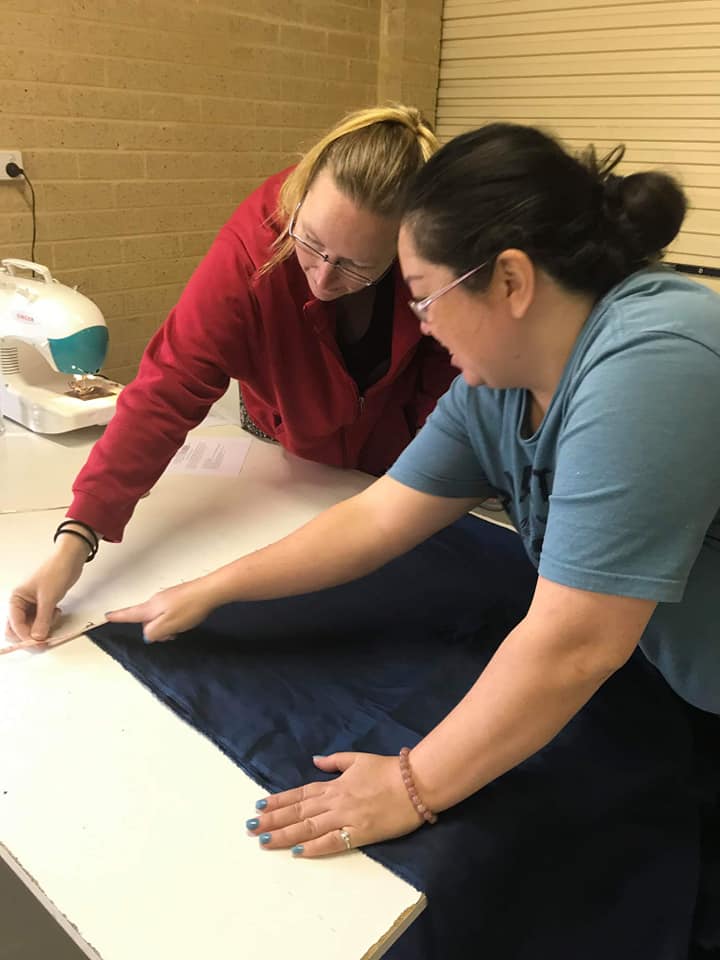
What to Bring
[Top]
For outdoor events, it is wise to bring a folding chair or a blanket to sit on. Carry a portable supply of water or other beverage, especially if you will be in the sun for part of the day. Bring a hat or other sunshade for protection. Working on a craft, project, or game can be a good way to meet others at an event when you tire of observing. Although at many events a feast is served in the evening, if you wish to eat earlier, you may need to bring your own lunch or snack. Avoid modern-looking food and drink containers or cover them with a cloth.
If the event you are attending includes a feast be sure you have made a reservation, if required, and that you bring or arrange to borrow “feasting gear”. This is:
- A spoon
- Knife
- Fork
- Plate
- Bowl
- Cloth Napkin
- Drinking vessel (cup or mug)
Period-looking items can be brought from op shops, or from other members who specialise in crafting these from wood, iron or ceramics.
You may also wish to bring a small cloth in case the table is uncovered, a fork, a bowl, small containers of sugar and salt, and a plastic trash bag to put dirty feast gear in after you have eaten. Many people bring their own beverage, as drinks are not always provided.
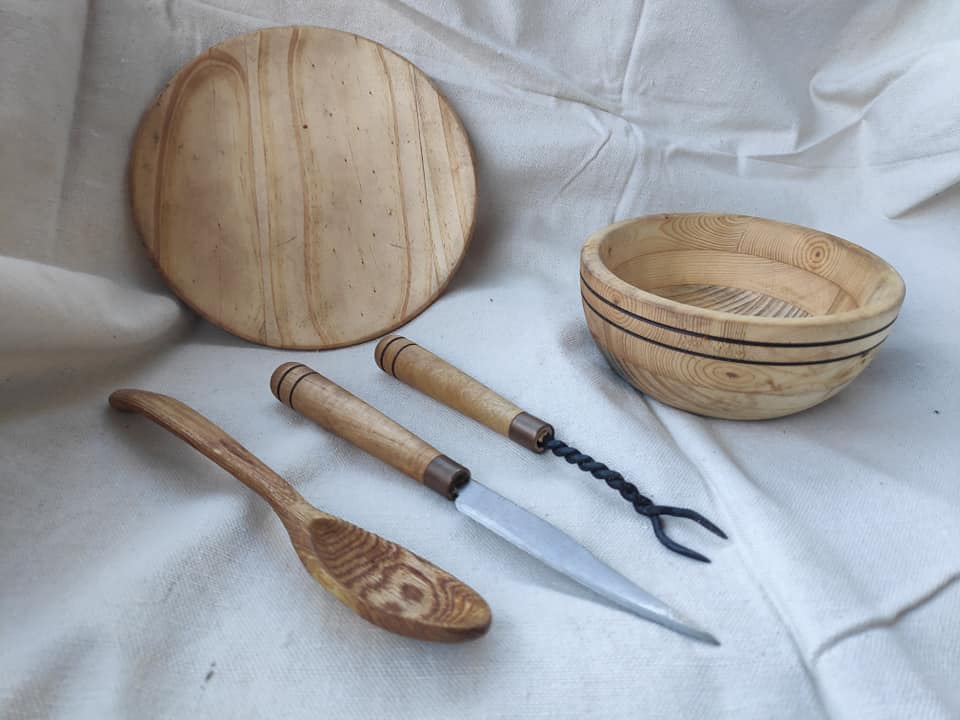
What to Do
[Top]
When you arrive on the event site, the first thing to do is check in at the gate with the Constable. Here you can pay the site fee and sign in. There may also be a timetable for you to check for scheduled tournaments and classes.
Set up a spot – you can usually approach people and ask if you may sit with them – people will welcome you into their encampment or pavilion. Make sure to be courteous and hide mundane items as much as possible. As long as you are making an effort you will fit in.
Feel free to attend classes offered. Learn a dance. Watch the armoured and rapier tournaments, or archery. Carry water to fighters and heralds. Offer to serve at the feast or in the kitchen. Attend Court with someone who can quietly explain what is going on. Most importantly, do not hesitate to involve yourself with other people at the event.
Ask people what they are doing. Approach and offer help. One of the things that makes the SCA special is the relationships that form between people and the willingness of our members to share knowledge.
When the event is over, make sure to leave the site as neat as when you arrived. Pick up and say goodbye to your new firneds, knowing that you will get to see them again at the next event, if not before.
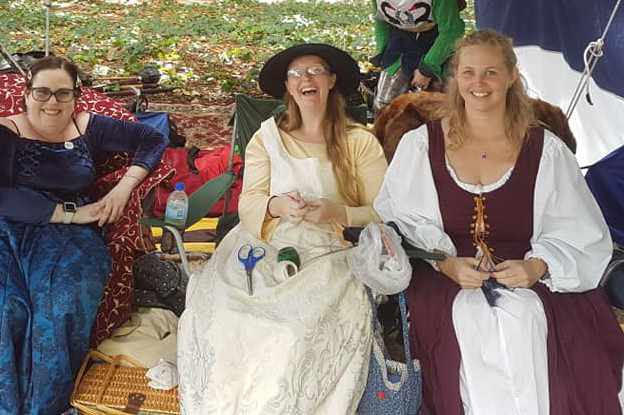
Who to Be
[Top]
Society members create a persona, the person who they would like to have been had they lived in the Middle Ages. Some SCA members have chosen only a name. Others have fully developed personas and can talk to you in detail about their medieval “lives”. When you meet someone, they will ask your name. If you have not chosen a medieval name you can use your modern one until you decide (eg. Andy of Dragons Bay). If you have no idea what you would like to be called, then ask the local Herald if they have a book (or website) of medieval names you can look at. Avoid using “name-the-baby” books; may of these names were coined after the Renaissance and the authors often do not tell you which names are modern ones.
You need to pick at least one name that parents would have given a child during the period the SCA studies, and at least one other name or descriptive phrase to set you apart from everyone else with that given name. Try to keep your name in only one language; two at the most. Your local Herald can give you further information on choosing a name and persona. Some things to remember when choosing a name:
- You may not take the name of any historical or legendary person, nor may you use the full name of a person in fictional literature
- You may not use or imply a title such as Sir, Duke, Count, Earl, Lord, Lady, Master, or Mistress. These titles must be earned.
- You may not use the full name of someone else in the Society.
Names can be registered in the Society, and more importantly, so can heraldry! The combination of colours and symbols, inspired by real medieval examples, can be registered to your new name. You can put them on your banners, chairs, paint your shield, and present your unique heraldry everywhere. Work with your local Herald to create something special that resonates with you.
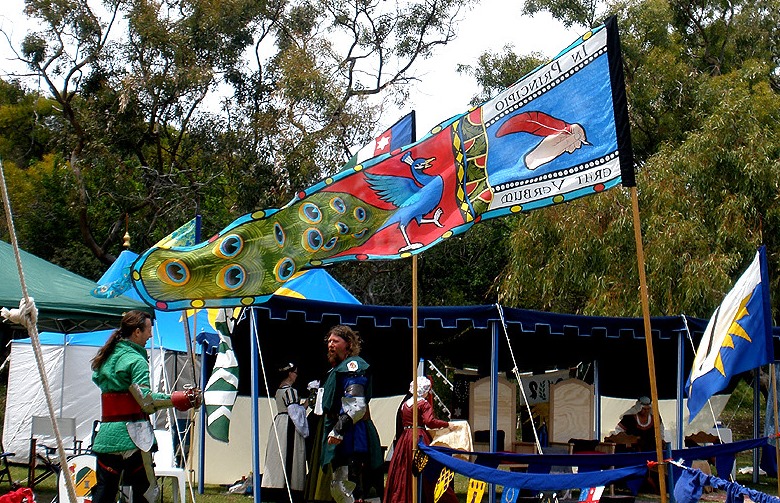
Who’s Who in the SCA
[Top]
Medieval society was highly structured with a system of ranks: kings, dukes, barons and lords. The SCA has a similar system of hierarchy. It is often difficult for a newcomer to tell if the person with whom he is conversing is “Somebody Important.” If you are in doubt, be courteous and polite, and address the person as “my lord” or “my lady.” These terms are widely used and acceptable to persons of all ranks.
People who wear crowns or coronets are “Somebody Important.” In many cases they are, or were, Royalty. They won the rights to wear a fancy circlet on their heads. It can be difficult to tell someone’s rank because a person of a lesser rank might choose to wear a fancier circlet than someone of higher rank; it partly depends on personal taste. If you are in doubt how to address someone, just ask them what their preference is.
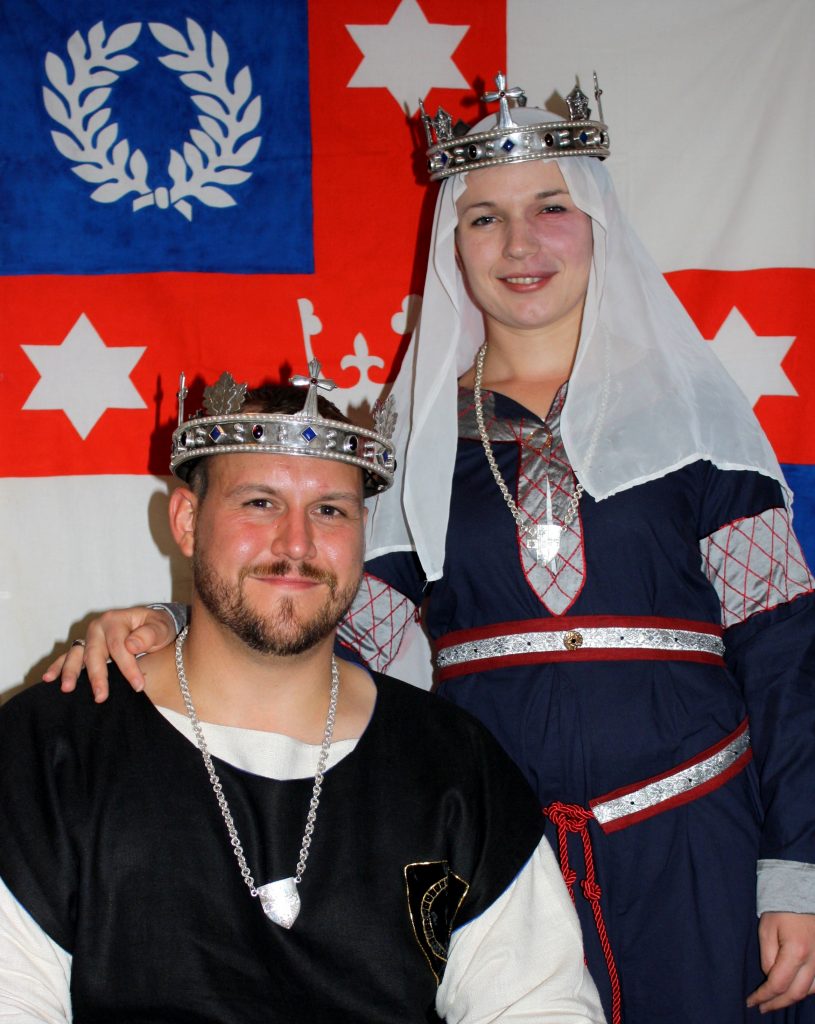
23rd Crown of Lochac: Niáll I and Liadan I
- King and Queen: Chosen by tournament combat. As the rulers of the entire Kingdom, they can make or change laws except where the new law would conflict with the Society’s rules (the Corpora) or the laws of the governments responsible for the area. They are addressed as “Sire,” “Your Majesty,” “My Lord King/My Lady Queen.” Remember that it is courteous to bow or curtsy when speaking to them or passing by them.
- Prince and Princess: The Crown Prince and Princess are heirs to the Kingdom, chosen by combat in the Crown Tourney. They are addressed as “Your Royal Highness.” They hold these titles until their coronation as King and Queen.
- Count or Countess: They have served once as King or Queen. Call them “Your Excellency.” Some alternate titles are Earl (Jarl, Iarll) and Graf.
- Duke or Duchess: They have served at least twice as King or Queen. Call them “Your Grace.”
- Viscount or Viscountess: They have served at least once as territorial Prince or Princess. Call them “Your Excellency.”
- Baron or Baroness: They oversee a large local group called a Barony and act as representatives of the Crown. Address them as “Your Excellency.”
- Court Baron or Baroness: The title is a reward from the Crown, often for exceptional service. However, they are not the heads of territories as are the other barons and baronesses. Address them as “Your Excellency.”
There are additional elevated ranks in the SCA: the Chivalry, the Laurels, and the Pelicans. They are collectively knows as the Peers of the Realm. In many kingdoms the Order of the Rose is also Peerage-level and in some Kingdoms the former royalty are called Royal Peers.
The Chivalry of the SCA consists of the Order of Knighthood and the Order of Mastery of Arms. Members are chosen by the Crown after consulting with the Chivalry for qualities of courtesy, grace and skill at arms. Knights swear fealty to the Crown and are entitled to wear a white belt. They wear a chain as a symbol of their fealty. Call them “Sir” (name). Mastery of Arms is for those persons who
choose not to swear fealty and is equal in rank to knighthood. They wear a white baldric but do not wear a chain since it represents fealty. Address them as “Master” (name) or “Mistress” (name). In most kingdoms, spurs are limited to the Chivalry as one of their signs of rank.
Members of the Order of Defense have been recognised by the Crown for their skills in rapier and/or cut-and-thrust combat along with the ‘peerage qualities’ of grace, courtesy, chivalry and service. Elevation to the order carries the award of a Patent of Arms and the right for the recipient to style themselves as Master or Mistress.
Members of the Order of the Laurel are chosen by the Crown after consultation with the Order for great skill in the Arts or Sciences, for their willingness to teach others, and for using their abilities to benefit their kingdom. They are addressed as “Master” or “Mistress” (name). Their insignia is a laurel wreath, usually colored green on a gold background. “Dame” is an increasingly common alternative for female Laurels and Pelicans. Some female Knights also use the title Dame instead of Sir.
Members of the Order of the Pelican have given of themselves to their Kingdom, usually for many years and without thought of reward. They are chosen by the Crown in consultation with the Order. Address them as “Master” or “Mistress” (name). Their insignia is a “pelican in her piety,” a pelican piercing her breast to feed her young with her own blood.
Members of the Order of the Rose are chosen from those individuals who have served their Kingdom by ruling as Queen or Consort. In many Kingdoms it is Peerage-level. In each Kingdom there are a number of different awards recognizing different levels of skill in the Arts or Sciences, fighting, or for hard work in behalf of the Kingdomor a local group. Ask the local herald or a local officer about your
Kingdom’s various awards.
The term “lord” or “lady” may refer to anyone in the Society if you do not know their rank, but the title “Lord” or “Lady” is reserved for those who have received an Award of Arms (AoA) from the Crown. This is often the first award granted to a person. It recognizes service to the kingdom or a local group and entitles the person to be called “Lord” or “Lady” (name) and to bear Arms.
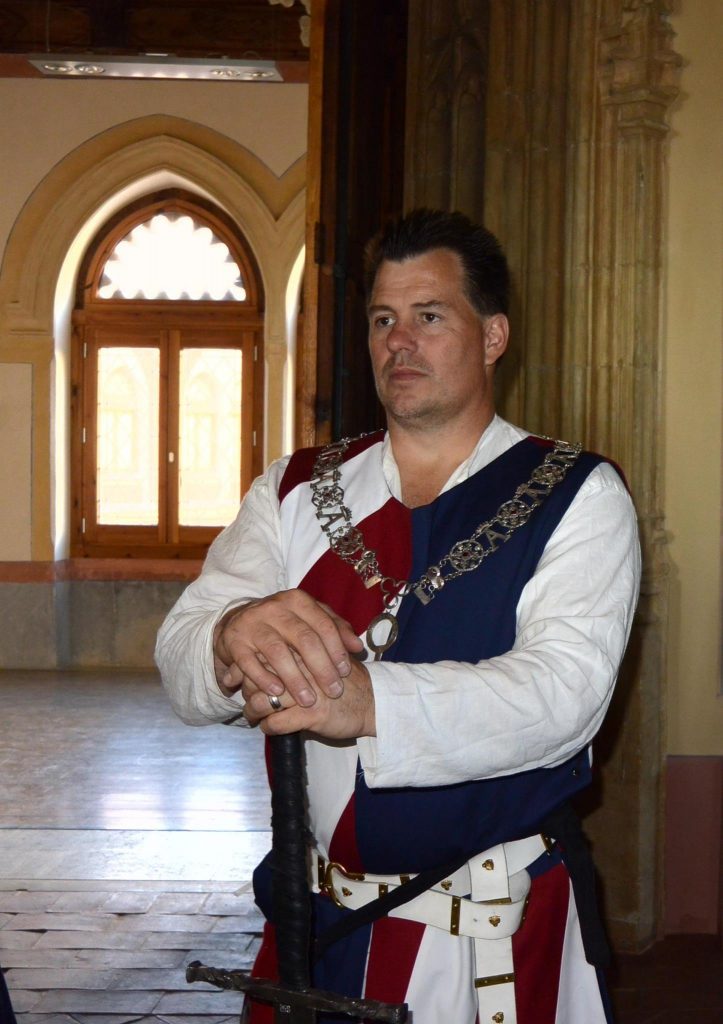
Children in the SCA
[Top]
What you do in the SCA is largely independent of age, except for combat activities. In general, those under 18 do not compete in armoured or rapier combat directly against adults. However, some Kingdoms offer both armoured and padded sword competition programs for youths and teens as well as youth rapier combat for teens.
Youth may also participate in archery, although there is a requirement for a guardian to be present during this and other youth activities. In addition, most events offer various educational children’s activities.
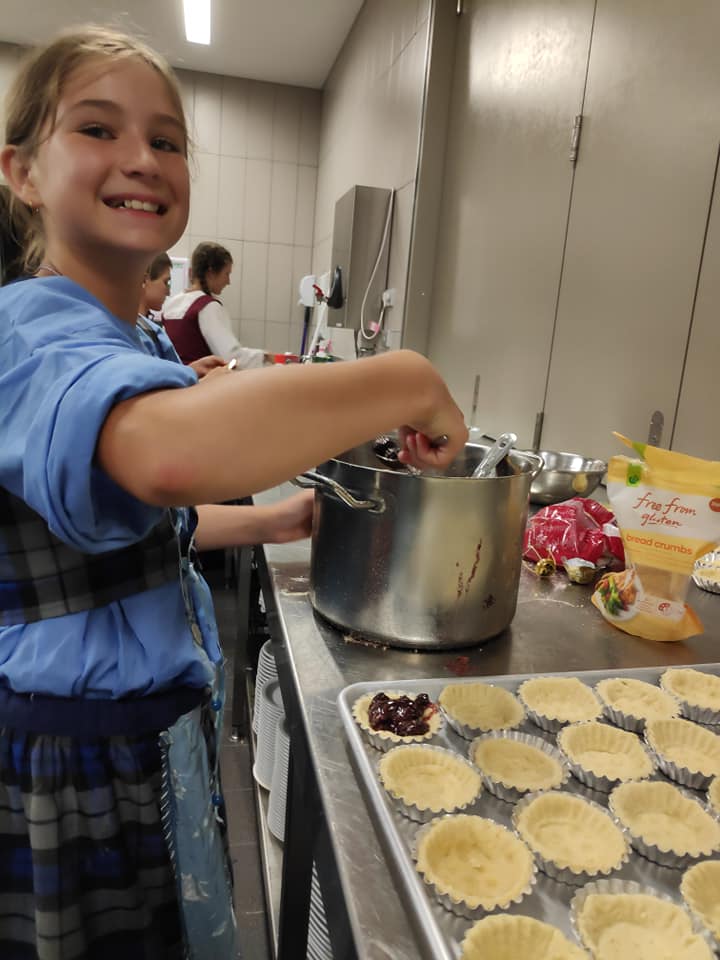
Local SCA Administrative Officers
[Top]
Finally, it is important for those new amongst us to realise that what makes a group strong, and an event successful, is the voluntary service of individual members. The SCA is not a show for outsiders to watch, but a living play into which new people can insert themselves.
Bureaucracy, the people who provide for the smooth running of things, abounded in the Middle Ages as well as in the modern world. The SCA is no different! If you have a question or do not know where to turn, start with the local officers. You will find similar offices on both the local and Kingdom levels. Officers in the SCA are appointed to their positions, not elected. Local officers are required to report periodically to their kingdom superiors. Some of the local officers are:
- Seneschal: the representative for the local group in the outside world. Acts as the chief administrative officer, similar to a group’s president.
- Herald: The local heraldic officer. In charge of making announcements and helping people research their names and heraldic devices in preparation for submission to the College of Heralds.
- Knight Marshal: In charge of the rules and regulations for fighting and archery. Sees to the safety of the participants. Keeps a record of who is authorized locally. Is responsible for seeing that fighters have an opportunity for training.
- Reeve: In charge of the financial affairs of the group.
- Minister of Arts and Sciences: Coordinates the study and practice of the medieval arts and sciences. See this officer if you have any questions in these areas or want to learn more about one of the skills and crafts.
- Chronicler: Publishes the group’s newsletter, which can range from a simple schedule of upcoming events to a booklet containing articles by local members.
- Webminister: Manages the website and email lists.
- Chirurgeon: Certified in the modern world in first aid. Usually available at events to provide first aid for minor injuries.
